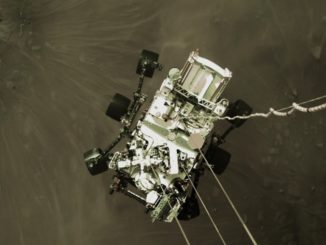

Along the way, a set of commercial off-the-shelf video cameras documented the descent, storing the imagery on board until it could be relayed back to Earth after touchdown. On 22 February, engineers at NASA’s Jet Propulsion Laboratory unveiled the results.
“This is the first time we’ve been able to actually capture an event like the landing of a spacecraft on Mars,” said JPL Director Michael Watkins. “We will learn something by looking at the performance of the vehicle in these videos. But a lot of it is also to bring you along on our journey, our touchdown to Mars, and of course, our surface mission as well. These are really amazing videos.”

An up-looking camera on the aeroshell captured the deployment and inflation, in about 0.7 seconds, of the rover’s 21.5-metre-wide (70.5-foot-wide) parachute, which slowed the craft from just under 1,600 kph (1,000 mph) to around 320 kph (200 mph). A camera mounted to the bottom of the rover showed the head shield dropping away a few moments later.
Perseverance, like the Curiosity rover before it, relied on a novel “sky crane” technique to reach the surface. Falling free of its parachute and backshell, a rocket-powered descent vehicle, carrying the rover bolted to its belly, began the final plunge to the surface.
A camera mounted on Perseverance’s jetpack showed the rover being lowered toward the surface on three long bridles as the exhaust plumes from the eight rocket engines began blowing swirling clouds of dust into the martian air. At the same time, a camera looking up from the rover showed the descent vehicle as it lowered its precious cargo.

Finally, amid near opaque clouds of dust, Perseverance’s six wheels touched the ground, the bridles were cut and the sky crane could be seen lifting away and flying out of sight to crash nearby.
Using the Mars Reconnaissance Orbiter, the Mars Odyssey and the European Space Agency’s Trace Gas Orbiter, Curiosity beamed back 30 gigabytes of data and 23,000 photographs over the next three days, sending the video and photos from the rover’s hazard-avoidance cameras.
The photos confirmed Perseverance came down in a flat, boulder-free area beyond the cliffs of a delta fanning out from an ancient river channel in the rim of Jezero Crater. Photos taken from orbit pinpointed the rover on the surface, along with the discarded heat shield, parachute and descent vehicle.

Along with the thousands of photos, being posted as they come in on the mission’s JPL web page, Perseverance also sent back data confirming its myriad systems are functioning normally as engineers work through a lengthy checkout. Its remote sensing mast was erected as planned and its high-gain antenna deployed.
Over the next two years, Perseverance will explore Jezero Crater and deposits laid down when the now-vanished river filled a 28-mile-wide lake, looking for signs of past microbial life. Promising samples will be loaded in small airtight tubes and cached on the surface for eventual retrieval and return to Earth.

Before the rover begins its primary mission, it will set a small $80 million drone on the surface for a sequence of test flights to test the feasibility of flying in the ultra thin atmosphere. Engineers say data from Perseverance shows the helicopter, mounted on the belly of the rover in a protective case, came through landing in good condition.



